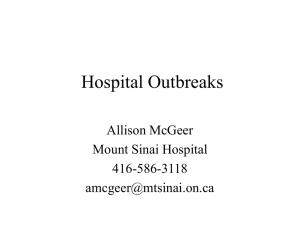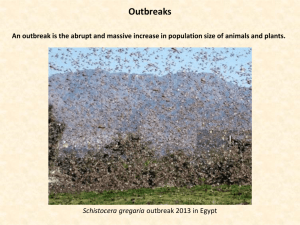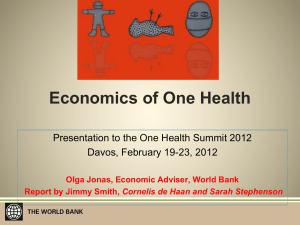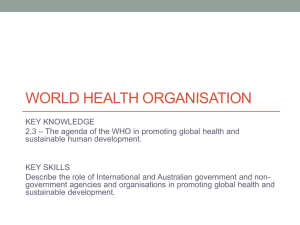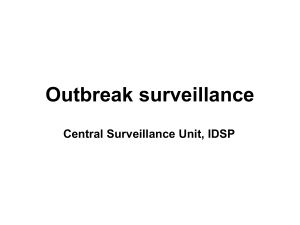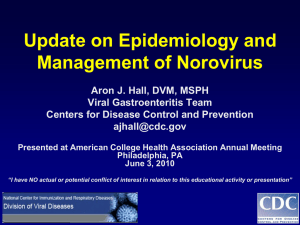Multijurisdictional Outbreaks
advertisement
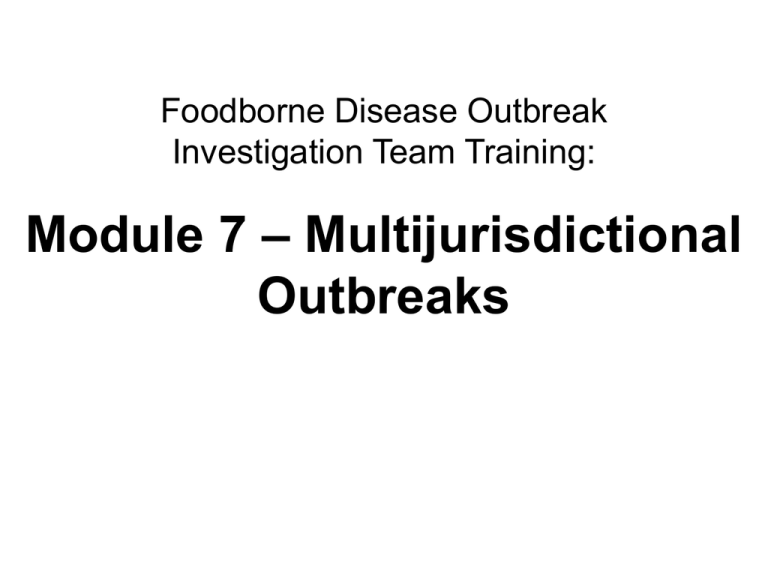
Foodborne Disease Outbreak Investigation Team Training: Module 7 – Multijurisdictional Outbreaks Multijurisdictional outbreaks 1 Module Learning Objectives At the end of this module, you will be able to 1. Discuss recent shifts in the nature of foodborne disease outbreaks. 2. List indicators that suggest an outbreak is likely to involve cases from multiple jurisdictions. 3. Describe federal public health agencies likely to participate in multijurisdictional investigations. 4. List clues that an outbreak might be due to intentional contamination. 5. State whether the local incident command system is activated during an outbreak response in your jurisdiction. Multijurisdictional outbreaks > Learning objectives 2 Traditional Outbreak Scenario Focal outbreak • Caused by local food handling error (endpoint contamination event) • Large number of cases in one jurisdiction • Detected by affected group • Local investigation • Local solution Multijurisdictional outbreaks 3 Traditional Outbreak Scenario (cont’d) Farm Production Processing Distribution Final preparation and cooking Localized cases Multijurisdictional outbreaks Problematic food safety practices 4 New Outbreak Scenario Dispersed outbreak • Caused by industrial contamination event (during production, processing, or distribution) with a widely distributed food • Small numbers of cases in many jurisdictions • Detected by pathogen-specific surveillance with subtyping • Multijurisdictional investigation • Solution that has broad implications Multijurisdictional outbreaks 5 Diffuse Outbreak Scenario (cont’d) Production Problematic food safety practices Farm Processing Distribution Final preparation and cooking Dispersed cases Multijurisdictional outbreaks 6 E. coli O157:H7 and Cookie Dough • Cluster of E. coli O157:H7 detected by PulseNet with cases from 13 states • No commonalities through initial case interviews; open-ended interviews in WA revealed 5 of 5 cases ate raw cookie dough • Multistate case-control study linked illness to Brand X cookie dough • Non-outbreak STEC isolated from cookie dough and flour supplier • 77 cases in 30 states Multijurisdictional outbreaks 7 Significance of Multijurisdictional Outbreaks • Small proportion (2%) of reported foodborne outbreaks are multistate • Disproportionate public health impact − 7% of outbreak-related illnesses − 31% of outbreak-related hospitalizations − 34% of outbreak-related deaths − 40% of E. coli O157:H7 and 25% of Salmonella and hepatitis A outbreaks Source: CDC, National Foodborne Disease Outbreak Surveillance System, unpublished data (2006-2010) Multijurisdictional outbreaks 8 Significance of Multijurisdictional Outbreaks (cont’d) Number of outbreaks Multistate foodborne outbreaks, 1989-2008 Year of Report Source: CDC, National Foodborne Disease Outbreak Surveillance System Multijurisdictional outbreaks 9 Reasons for Increase • Centralized production and wide distribution of food products • Globalization of food supply • Increased detection of outbreaks through – Improved surveillance efforts – Subtyping of causative agents – Information sharing Multijurisdictional outbreaks 10 Local Significance of Multijurisdictional Outbreaks • “Local” outbreak may herald a national or international event. Multijurisdictional outbreaks 11 Listeriosis and Cantaloupe • Seven cases of listeriosis reported from CO • All had eaten cantaloupe in month before illness • Cases in other states detected through PulseNet; comparisons of outbreak-related and non-outbreak related listeriosis cases confirm cantaloupe link • Traceback converges on CO producer that shipped cantaloupe to 24 states • 146 cases from 28 states Multijurisdictional outbreaks 12 Multijurisdictional Outbreak Indicators • Implicated food contaminated before point of service and is – Commercially distributed, processed, or readyto-eat item – Fresh produce item – Ground beef in E. coli O157:H7 outbreak • Illnesses linked to multiple food-service establishments • Molecular subtype of causative agent matches agent associated with outbreaks in other locations • Exposed persons have subsequently dispersed Multijurisdictional outbreaks 13 Class Question Which of the following outbreaks are likely to involve cases residing in multiple jurisdictions? Multiple Illness linked to food safety problem at elementary school cafeteria jurisdictions No Outbreak associated with national brand food; no local contributing factors identified Yes Cases linked to food purchased from several different restaurants in one city Yes Outbreak linked to food served on airline flight Yes Multijurisdictional outbreaks 14 Local Significance of Multijurisdictional Outbreaks • “Local” outbreak may herald a national or international event. • Local jurisdictions will need to coordinate investigation efforts with other local, state, and federal partners. Multijurisdictional outbreaks 15 Federal Public Health Agencies • Centers for Disease Control and Prevention (CDC) - Non-regulatory agency that focuses on disease surveillance, outbreak detection, and investigation • U.S. Department of Agriculture/Food Safety and Inspection Service (USDA/FSIS) - Regulatory agency that oversees safety of meat, poultry, and pasteurized egg products • U.S. Food and Drug Administration (FDA) Regulatory agency that oversees safety of most foods except meat, poultry, and pasteurized egg products Multijurisdictional outbreaks > Federal public health agencies 16 Federal Agency Contributions to Outbreak Investigation • • • • Leadership and coordination Expertise and experience Laboratory testing Other resources (e.g., manpower, educational materials) • Public health regulatory authority over certain control measures (e.g., recalls) Multijurisdictional outbreaks > Federal public health agencies 17 When to Involve Federal Agencies • Outbreaks associated with – Cases from multiple states (or countries) – Commercially distributed food contaminated before point of service – Highly pathogenic or unusual causative agent – Large numbers of cases that require additional resources to investigate – Intentional contamination suspected • Request for assistance through state epidemiologist Multijurisdictional outbreaks > Federal public health agencies 18 Local Significance of Multijurisdictional Outbreaks • “Local” outbreak may herald a national or international event. • Local jurisdictions will need to coordinate investigation efforts with other local, state, and federal partners. • Local jurisdictions may be asked to urgently investigate one or a few cases that are part of a larger outbreak despite their apparently small local impact. Multijurisdictional outbreaks 19 Anatomy of a Multijurisdictional Outbreak (1) • March 1: NY State notifies CDC of 4 persons infected with Salmonella Bareilly with unusual PFGE pattern. Vigilant state health department quickly brings attention to problem. Multijurisdictional outbreaks 20 Anatomy of a Multijurisdictional Outbreak (1) • March 1: NY State notifies CDC of 4 persons infected with Salmonella Bareilly with unusual PFGE pattern. • March 2: PulseNet shows 11 persons in 7 states with the same pattern. CDC initiates multistate investigation and holds first conference call. Rapid communication ensues between local, state, and federal public health partners; states share case information during conference call and are asked to use same hypothesis-generating questionnaire. Multijurisdictional outbreaks 21 Anatomy of a Multijurisdictional Outbreak (1) • March 1: NY State notifies CDC of 4 persons infected with Salmonella Bareilly with unusual PFGE pattern. • March 2: PulseNet shows 11 persons in 7 states with the same pattern. CDC initiates multistate investigation and holds first conference call. • March 8: Interviews of 8 ill persons reveal 7 ate seafood and 5 ate sushi before illness. Since most states have only 1-2 cases, comparison of case information across states is critical for hypothesis generation. Multijurisdictional outbreaks 22 Anatomy of a Multijurisdictional Outbreak (2) • March 8-13: TX and WI each report cluster of unrelated cases who ate a same Japanese restaurant. Focused hypothesis generating questionnaire deployed. New hypothesis-generating questionnaire to be used by all investigators focuses on sushi; restaurant clusters allow initiation of traceback studies. Multijurisdictional outbreaks 23 Anatomy of a Multijurisdictional Outbreak (2) • March 8-13: TX and WI each report cluster of unrelated cases who ate a same Japanese restaurant. Focused hypothesis generating questionnaire deployed. • March 15: FDA begins receiving supplier and invoice data. Local and state staff collect invoices, receipts, and bills of lading from food establishments associated with clusters. Multijurisdictional outbreaks 24 Anatomy of a Multijurisdictional Outbreak (2) • March 8-13: TX and WI each report cluster of unrelated cases who ate a same Japanese restaurant. Focused hypothesis generating questionnaire deployed. • March 15: FDA begins receiving supplier and invoice data. • March 16-27: WI, CT, and MD report clusters that ate sushi from same store/restaurant; based on 20 case interviews, >90% ate sushi, primarily spicy tuna. States search for cases related to outbreak and complete interviews; link to sushi strengthens. Multijurisdictional outbreaks 25 Anatomy of a Multijurisdictional Outbreak (3) • March 29-April 9: Comparison of meal receipts at 4 restaurants shows 84% of case meals and 37% of meals of other customers contained spicy tuna. Local and state staff undertake study at restaurants linked to outbreak. Multijurisdictional outbreaks 26 Anatomy of a Multijurisdictional Outbreak (3) • March 29-April 9: Comparison of meal receipts at 4 restaurants shows 84% of case meals and 37% of meals of other customers contained spicy tuna. • April 10: WI reports 5 Salmonella Nchanga infections in same states as S. Bareilly cases. One ate at same restaurant as S. Bareilly case; one was chef at restaurant where S. Bareilly case ate. Continued sharing of information brings new twist Multijurisdictional outbreaks 27 Anatomy of a Multijurisdictional Outbreak (3) • March 29-April 9: Comparison of meal receipts at 4 restaurants shows 84% of case meals and 37% of meals of other customers contained spicy tuna. • April 10: WI reports 5 Salmonella Nchanga infections in same states as S. Bareilly cases. One ate at same restaurant as S. Bareilly case; one was chef at restaurant where S. Bareilly case ate. • April 13-14: Producer is identified, recalls yellowfin tuna from processing facility in India; CDC Recall based on data and FDA warn public. Multijurisdictional outbreaks collected by states and analyzed by FDA. 28 Anatomy of a Multijurisdictional Outbreak (4) • April 19-24: FDA conducts inspection at processing facility noting several seafood HACCP deficiencies and sanitation concerns. Multijurisdictional outbreaks 29 Anatomy of a Multijurisdictional Outbreak (4) • April 19-24: FDA conducts inspection at processing facility noting several seafood HACCP deficiencies and sanitation concerns. • April 24-26: S. Bareilly is isolated from recalled tuna and spicy tuna roll made with recalled tuna; outbreak strains of S. Bareilly and Nchanga found in unopened packages of yellowfin tuna product from producer. Multijurisdictional outbreaks 30 Anatomy of a Multijurisdictional Outbreak (4) • April 19-24: FDA conducts inspection at processing facility noting several seafood HACCP deficiencies and sanitation concerns. • April 24-26: S. Bareilly is isolated from recalled tuna and spicy tuna roll made with recalled tuna; outbreak strains of S. Bareilly and Nchanga found in unopened packages of yellowfin tuna product from producer. • Total 425 cases from 28 states and D.C. Multijurisdictional outbreaks 31 Role of State and Local Jurisdictions in Multijurisdictional Outbreaks • Notify others of local outbreaks. • Be aware of outbreaks in other jurisdictions. • Search for local cases/clusters associated with multijurisdictional outbreak. • Participate in hypothesis generation. • Perform tasks (e.g., interview cases, undertake studies) as agreed upon. • Collect paperwork to support traceback investigations by federal agencies. Multijurisdictional outbreaks 32 Intentional Contamination Multijurisdictional outbreaks 33 Intentional Contamination of Food • Few documented incidents • Food vulnerable target • Vigilance and heightened awareness regarding tampering with food supply are essential Multijurisdictional outbreaks > Intentional contamination 34 Nicotine Poisoning and Ground Beef • Supermarket customers in MI complain of burning of the mouth, nausea, vomiting, and dizziness following consumption of ground beef purchased on certain dates • Supermarket recalls 1,700 lbs. beef from out-ofstate processor that was ground at the store • Samples of ground beef found positive for nicotine • Local health department identifies over 90 cases • Employee indicted by grand jury Multijurisdictional outbreaks > Intentional contamination 35 Public Health Clues • Likely to mimic unintentional foodborne outbreak Env’t Health Unusual food Contamination without clear natural pathway Contamination at unexpected step in production Evidence of tampering Multiple exposure sites or foods with no apparent link Epidemiologic Large number of cases in short time Multiple labs or states in short time Setting of large exposure numbers Unusual illness, treatment response, high hospitalization and death rate Unseasonal pattern Laboratory High concentration of causative agent in implicated food Unusual agent Unexpected agent for food Combination of agents Isolates from unrelated foods Multijurisdictional outbreaks > Intentional contamination 36 Nicotine Poisoning and Ground Beef (cont’d) Hints of intentional contamination • Nicotine as a contaminant of ground beef • 300 mg/kg of nicotine in implicated ground beef • Contamination limited to single store • Nicotine-containing pesticides not used at store • Source of nicotine thought to be Black Leaf 40, an insecticide formulation discontinued in 1992 Multijurisdictional outbreaks > Intentional contamination 37 Investigation of Intentional Contamination • Follows same approach as for all outbreaks until intentional contamination suspected • Then everything changes!!! – Different partners with different objectives – Added steps (e.g., parallel investigation by law enforcement) – Special issues (e.g., safety of team members, proper handling of specimens, capacity of laboratory to test for unusual agents) • Importance of developing working relationship with possible partners BEFORE incident occurs Multijurisdictional outbreaks > Intentional contamination 38 Incident Command System Multijurisdictional outbreaks 39 Incident Command System (ICS) • Management system that helps multiple agencies work together • Supports and coordinates necessary activities and communications • Has operating rules and processes Multijurisdictional outbreaks > Incident Command System 40 Salmonella and Public Water System • • • • Salmonella outbreak in Alamosa, Colorado 442 illnesses and one death Source determined to be public water system Colorado Safe Drinking Water program focused on correcting problems with public water system • ICS helped to manage others aspects of response including − Bulk water delivery − Public notification of advisories and updates − Interagency coordination Multijurisdictional outbreaks > Incident Command System 41 Activation of ICS in Outbreak Response? • Determined by agency/jurisdiction − Some jurisdictions use ICS extensively − Others do not • Triggers for involvement should be decided in advance • Necessary integration of ICS into response planning and team training, if decision is made to activate system under certain circumstances Multijurisdictional outbreaks > Incident Command System 42 Class Question 1. Is the Incident Command System (ICS) activated in your jurisdiction when a foodborne outbreak is detected? 2. If so, under what circumstances is it activated? Multijurisdictional outbreaks > Incident Command System 43 Quick Quiz Multijurisdictional outbreaks 44 Quick Quiz 1. Which of the following is a likely reason for the increase in multijurisdictional outbreaks in recent years? A. Food produced in the United States is less safe than it used to be B. Improved ability to link cases of foodborne illness due to subtyping efforts C. Antibiotic use in livestock D. Increased interest in locally produced foods sold through farmer’s markets Multijurisdictional outbreaks 45 Quick Quiz 2. All of the following characteristics suggest that cases associated with a local outbreak might reside in multiple jurisdictions EXCEPT A. Implicated food was widely distributed. B. Contributing factors were found at the implicated restaurant during the environmental health assessment. C. Illness among cases was linked to multiple restaurants. D. Outbreak was linked to an event that drew participants from many states. Multijurisdictional outbreaks 46 Quick Quiz 3. Which of the following is a likely contribution of federal public health agencies to a multijurisdictional foodborne outbreak investigation. A. Expertise and experience B. Resources such as laboratory testing C. Leadership and coordination D. All of the above Multijurisdictional outbreaks 47 Quick Quiz 4. Only uncommon microbial agents are associated with intentional outbreaks. A. True B. False Multijurisdictional outbreaks 48 Quick Quiz 5. Which of the following statements about the incident command system (ICS) is correct? A. The health department should not activate the ICS until the situation reaches a crisis. B. ICS operating rules and processes can help multiple agencies work together efficiently and effectively. C. It is recommended that the local ICS be activated in all foodborne outbreaks. D. Involved agencies will be familiar with public health and foodborne diseases. Multijurisdictional outbreaks 49
